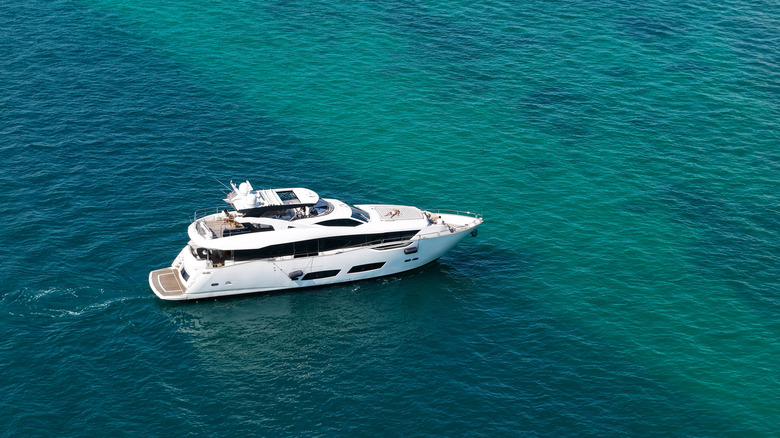How Long Does It Take A Yacht To Cross The Atlantic Ocean?
Sailing across the Atlantic Ocean used to be a monumental feat.The difficulty of this journey even led to the seafaring tradition of sailors getting an anchor tattoo to mark the completion of a transatlantic crossing. While crossing the Atlantic might not seem like such an accomplishment now that you can fly from North America to Europe and back in a single day, the voyage was quite challenging and perilous a couple of centuries ago.
Today, transatlantic maritime travel is largely the realm of cargo and cruise ships. Luxurious ocean liners used to zip passengers back and forth regularly, but the Queen Mary II is essentially the world's last remaining ocean liner. These fast-moving vessels have mostly been replaced by well-appointed cruise ships, which offer a relaxed, resort-like experience on the water. Yachts are another great way to cross the Atlantic, and provide passengers a more personalized experience. Transatlantic yachting trips aren't for inexperienced sea travelers, though, as journeys on these smaller ships can be rough and take up to a month or more. You can also volunteer as a crew member on a transatlantic yacht to learn more about how to safely make the crossing, and you'll save money and grow stronger sea legs with each successive trip.
If you have the means, you can charter a yacht and enjoy the luxury of traveling on a private vessel with a dedicated crew. The best yachts offer spacious cabins, great food, and onboard diversions for passengers to enjoy while the crew takes care of essential tasks like navigating, piloting, and maintaining the boat. The fastest motorized superyachts can cross the Atlantic in about nine days, while large sailing yachts will typically take three to four weeks to make the crossing.
Yacht routes vary by season and boat type
While the aerodynamic 25-meter (82 foot) Bolide 80 can travel at an impressive 70 knots (84 mph), most motor yachts generally cruise at speeds ranging from 8 to 15 knots (9.2-17.2 mph). At that rate, a typical transatlantic journey takes just under two weeks if the weather remains favorable. At its top speed, the Bolide 80 could cover the 2,925 nautical miles from New York to Lisbon in just under 42 hours. The cost of chartering a yacht depends on the duration of the trip, so a transatlantic journey on a comfortable superyacht can cost anywhere from several hundred thousand to a few million dollars. On the bright side, you get an entire crew dedicated to serving you and ushering you safely across the Atlantic. Some yachts also have helipads, allowing for guests to join or leave the journey midway.
The crossing time is significantly longer on sailing yachts that depend on the wind for propulsion, which is one of the reasons why modern ships don't use sails). A typical northern Atlantic crossing on such a vessel will take 15 to 30 days, with southern crossings adding five to 10 days more. In comparison, cargo ships cross the Atlantic in 10 to 20 days. There are some ships that take slightly longer and provide a mix of adventure, luxury, and training for a cost between that of an ocean liner and a chartered yacht. If a private charter is beyond your budget, an arrangement like this allows you to exchange some time helping with basic tasks for the chance to learn some new skills like navigating in the open ocean. You'll still enjoy the crossing and get the bonus of an authentic sailing experience, and maybe a cool anchor tattoo as well.
Yachts travel on seasonal routes during certain months
In comparison, cruise ships and ocean liners typically take about a week to cross the Atlantic. Because yachts are limited in size and passenger capacity, chartering one to cross the Atlantic will cost you much more than passage on a cruise ship or ocean liner. Timing is also a factor in planning a transatlantic yacht crossing. For example, the east coast of North America experiences potentially dangerous weather during hurricane season in late summer and early fall, so many smaller vessels avoid making transatlantic journeys between June and November. Yachts also favor routes where the trade winds favor the direction of travel, making crossings faster, easier, and less expensive. While going from west to east, yacht captains often prefer crossing during the late spring months of April and May, before the weather gets too warm.
Rather than heading straight to the Canary Islands, sailing yachts leaving North America sometimes first head to Bermuda to pick up favorable winds, adding close to 3,000 miles of travel. Heading up the coast to Canada's Newfoundland and turning east toward the United Kingdom cuts the crossing to about 2,000 miles, but introduces hazards from cold weather, fog, and icebergs. The period between November and January is best for journeys from east to west across the Atlantic, as this timing allows vessels to avoid hurricane season and still arrive to warm weather in and around the Gulf of Mexico.


